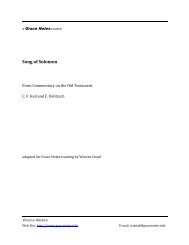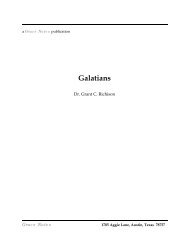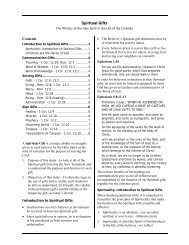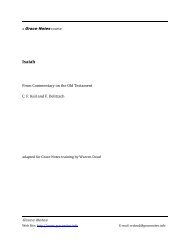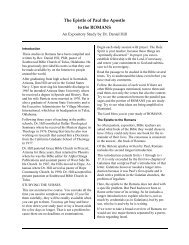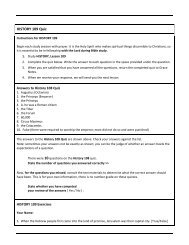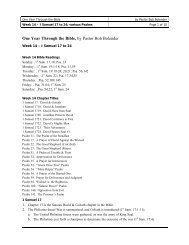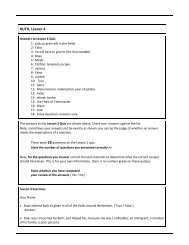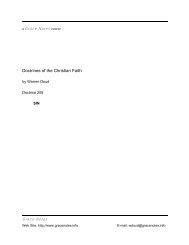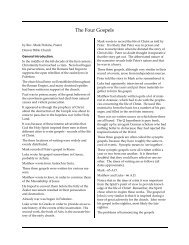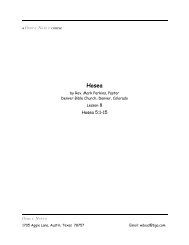Create successful ePaper yourself
Turn your PDF publications into a flip-book with our unique Google optimized e-Paper software.
<strong>Apostolic</strong> <strong>Fathers</strong> 8(2) <strong>The</strong> long recension consists of thirteenletters in all, in the following order: two fromAntioch — one from a certain Mary ofCassobola (a neighboring town) to Ignatius, andIgnatius’ letter to her in reply; the four fromSmyrna and three from Troas found in the shortrecension; three from Philippi, to Tarsus,Antioch, and Hero (Ignatius’ successor asbishop of Antioch); and one from Italy toPhilippi. In addition there are some extensiveinterpolations in the seven letters from Smyrnaand Troas mentioned by Eusebius. In the earlyMiddle Ages this collection was enlarged stillfurther by two letters to the apostle John, one toMary the mother of Jesus, and one from Mary toIgnatius in return! Even though these latterwere soon rejected as forgeries, the works ofIgnatius continued to be known in the Churchonly in the long recension until the middle ofthe 17th century.(3) <strong>The</strong> Syriac abridgement, discovered by W.Cureton in 1845, is a Syriac version consistingof only three epistles (to the Ephesians, to theRomans, and to Polycarp), similar in form to theshort recension.<strong>The</strong> dominance of the long recension began tobe broken in 1644 when Archbishop JamesUssher published an edition of Ignatius basedon two medieval Latin MSS which, whilecontaining all the letters of the long recension,provided an uninterpolated text of the sevencore epistles known to Eusebius. Soonafterward a Greek MS was found whichconfirmed the existence of the short recension.It contained the epistles of the short recensionin the same uninterpolated form, except forRomans; a martyrological text discovered a fewdecades later supplied this lack with a similarlyshort text of Romans. Since then, as the result ofcareful investigations of <strong>The</strong>odor Zahn, J. B.Lightfoot, and others, scholarship came to apoint of virtual consensus in favor of the shortrecension. Though some for a time defendedthe originality of the Syriac abridgment, theconsensus still stands. In addition to the Greekand Latin witnesses and the Syriac abridgmentmentioned above, there are fragments in Greek,Syriac, and Coptic, and an Armenian version.In his letter to Polycarp, Ignatius states that hewas unable to write to all the churches becausehe was taken on short notice from Troas toNeapolis on the Macedonian coast. He asksPolycarp to write to the churches that lay aheadon his itinerary, so that they might have newsof Ignatius and send messengers or letters tohim (Ign Polyc 8:1). <strong>The</strong> first of these churcheswould be the one at Philippi, and we havePolycarp’s letter to this church, in which hestates clearly that he is sending them “theletters of Ignatius, which were sent to us byhim, and others which we had by us” (PolycPhil. 13:2). Presumably these would includeIgnatius’ letters to Smyrna and to Polycarp aswell as copies of the four letters written fromSmyrna (i.e., all the letters except that to thePhiladelphians, a copy of which may have beensent to Polycarp as well). Thus Polycarp wasthe earliest collector of the Ignatian corpus andthe person chiefly responsible for itspreservation.Without discussing each of Ignatius’ letters indetail, it can be said that they share a commonstructure which enables the reader to knowmore or less what to expect: first there is anelaborate salutation with praise for the churchand its bishop; then often an appeal to live inharmony with the bishop; then usually someattention to the particular heresy threateningthe church; and finally some reference toIgnatius’ own situation and that of the church inSyria.<strong>The</strong> theology and Christology of Ignatius arisesout of a life situation in which three factorswere at work: (1) his sense of impendingmartyrdom, (2) his awareness of the threat ofheresy and schism, and (3) his concern forunity in the churches under the authority of thebishop.(1) <strong>The</strong> factor of martyrdom looms largest inhis letter to the Romans, where his aim is tomake sure that the church at Rome doesnothing to prevent his execution by the Romanauthorities. For him to die as a martyr is to“attain to God” (Ign Rom. 1:2; 2:1; 9:2) or toChrist (5:3), to “become a disciple” (4:2; 5:1, 3)or a true Christian (3:2), to be reborn (6:1) andthus fully to “become a man” (6:2). His death isa sacrifice (2:2; 4:2), sometimes specifically aeucharistic sacrifice. For Ignatius, violent deathmeans participation in the sacrifice of the flesh



